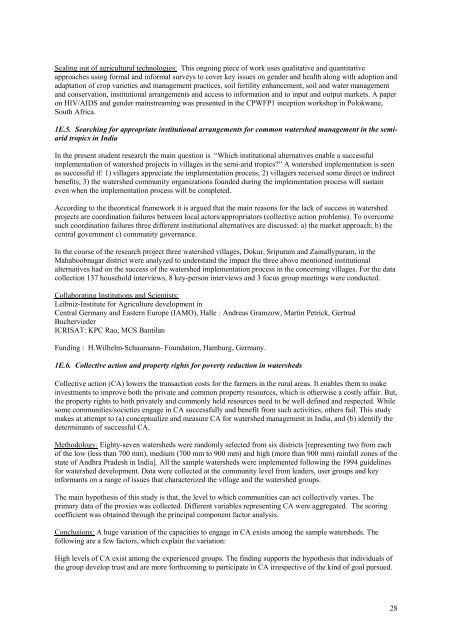ICRISAT Archival Report 2006 - The seedlings of success in the ...
ICRISAT Archival Report 2006 - The seedlings of success in the ...
ICRISAT Archival Report 2006 - The seedlings of success in the ...
Create successful ePaper yourself
Turn your PDF publications into a flip-book with our unique Google optimized e-Paper software.
Scal<strong>in</strong>g out <strong>of</strong> agricultural technologies: This ongo<strong>in</strong>g piece <strong>of</strong> work uses qualitative and quantitative<br />
approaches us<strong>in</strong>g formal and <strong>in</strong>formal surveys to cover key issues on gender and health along with adoption and<br />
adaptation <strong>of</strong> crop varieties and management practices, soil fertility enhancement, soil and water management<br />
and conservation, <strong>in</strong>stitutional arrangements and access to <strong>in</strong>formation and to <strong>in</strong>put and output markets. A paper<br />
on HIV/AIDS and gender ma<strong>in</strong>stream<strong>in</strong>g was presented <strong>in</strong> <strong>the</strong> CPWFP1 <strong>in</strong>ception workshop <strong>in</strong> Polokwane,<br />
South Africa.<br />
1E.5. Search<strong>in</strong>g for appropriate <strong>in</strong>stitutional arrangements for common watershed management <strong>in</strong> <strong>the</strong> semiarid<br />
tropics <strong>in</strong> India<br />
In <strong>the</strong> present student research <strong>the</strong> ma<strong>in</strong> question is “Which <strong>in</strong>stitutional alternatives enable a <strong>success</strong>ful<br />
implementation <strong>of</strong> watershed projects <strong>in</strong> villages <strong>in</strong> <strong>the</strong> semi-arid tropics?” A watershed implementation is seen<br />
as <strong>success</strong>ful if: 1) villagers appreciate <strong>the</strong> implementation process; 2) villagers received some direct or <strong>in</strong>direct<br />
benefits; 3) <strong>the</strong> watershed community organizations founded dur<strong>in</strong>g <strong>the</strong> implementation process will susta<strong>in</strong><br />
even when <strong>the</strong> implementation process will be completed.<br />
Accord<strong>in</strong>g to <strong>the</strong> <strong>the</strong>oretical framework it is argued that <strong>the</strong> ma<strong>in</strong> reasons for <strong>the</strong> lack <strong>of</strong> <strong>success</strong> <strong>in</strong> watershed<br />
projects are coord<strong>in</strong>ation failures between local actors/appropriators (collective action problems). To overcome<br />
such coord<strong>in</strong>ation failures three different <strong>in</strong>stitutional alternatives are discussed: a) <strong>the</strong> market approach; b) <strong>the</strong><br />
central government c) community governance.<br />
In <strong>the</strong> course <strong>of</strong> <strong>the</strong> research project three watershed villages, Dokur, Sripuram and Za<strong>in</strong>allypuram, <strong>in</strong> <strong>the</strong><br />
Mahaboobnagar district were analyzed to understand <strong>the</strong> impact <strong>the</strong> three above mentioned <strong>in</strong>stitutional<br />
alternatives had on <strong>the</strong> <strong>success</strong> <strong>of</strong> <strong>the</strong> watershed implementation process <strong>in</strong> <strong>the</strong> concern<strong>in</strong>g villages. For <strong>the</strong> data<br />
collection 137 household <strong>in</strong>terviews, 8 key-person <strong>in</strong>terviews and 3 focus group meet<strong>in</strong>gs were conducted.<br />
Collaborat<strong>in</strong>g Institutions and Scientists:<br />
Leibniz-Institute for Agriculture development <strong>in</strong><br />
Central Germany and Eastern Europe (IAMO), Halle : Andreas Gramzow, Mart<strong>in</strong> Petrick, Gertrud<br />
Buchervieder<br />
<strong>ICRISAT</strong>: KPC Rao, MCS Bantilan<br />
Fund<strong>in</strong>g : H.Wilhelm-Schaumann- Foundation, Hamburg, Germany.<br />
1E.6. Collective action and property rights for poverty reduction <strong>in</strong> watersheds<br />
Collective action (CA) lowers <strong>the</strong> transaction costs for <strong>the</strong> farmers <strong>in</strong> <strong>the</strong> rural areas. It enables <strong>the</strong>m to make<br />
<strong>in</strong>vestments to improve both <strong>the</strong> private and common property resources, which is o<strong>the</strong>rwise a costly affair. But,<br />
<strong>the</strong> property rights to both privately and commonly held resources need to be well def<strong>in</strong>ed and respected. While<br />
some communities/societies engage <strong>in</strong> CA <strong>success</strong>fully and benefit from such activities, o<strong>the</strong>rs fail. This study<br />
makes at attempt to (a) conceptualize and measure CA for watershed management <strong>in</strong> India, and (b) identify <strong>the</strong><br />
determ<strong>in</strong>ants <strong>of</strong> <strong>success</strong>ful CA.<br />
Methodology: Eighty-seven watersheds were randomly selected from six districts [represent<strong>in</strong>g two from each<br />
<strong>of</strong> <strong>the</strong> low (less than 700 mm), medium (700 mm to 900 mm) and high (more than 900 mm) ra<strong>in</strong>fall zones <strong>of</strong> <strong>the</strong><br />
state <strong>of</strong> Andhra Pradesh <strong>in</strong> India]. All <strong>the</strong> sample watersheds were implemented follow<strong>in</strong>g <strong>the</strong> 1994 guidel<strong>in</strong>es<br />
for watershed development. Data were collected at <strong>the</strong> community level from leaders, user groups and key<br />
<strong>in</strong>formants on a range <strong>of</strong> issues that characterized <strong>the</strong> village and <strong>the</strong> watershed groups.<br />
<strong>The</strong> ma<strong>in</strong> hypo<strong>the</strong>sis <strong>of</strong> this study is that, <strong>the</strong> level to which communities can act collectively varies. <strong>The</strong><br />
primary data <strong>of</strong> <strong>the</strong> proxies was collected. Different variables represent<strong>in</strong>g CA were aggregated. <strong>The</strong> scor<strong>in</strong>g<br />
coefficient was obta<strong>in</strong>ed through <strong>the</strong> pr<strong>in</strong>cipal component factor analysis.<br />
Conclusions: A huge variation <strong>of</strong> <strong>the</strong> capacities to engage <strong>in</strong> CA exists among <strong>the</strong> sample watersheds. <strong>The</strong><br />
follow<strong>in</strong>g are a few factors, which expla<strong>in</strong> <strong>the</strong> variation:<br />
High levels <strong>of</strong> CA exist among <strong>the</strong> experienced groups. <strong>The</strong> f<strong>in</strong>d<strong>in</strong>g supports <strong>the</strong> hypo<strong>the</strong>sis that <strong>in</strong>dividuals <strong>of</strong><br />
<strong>the</strong> group develop trust and are more forthcom<strong>in</strong>g to participate <strong>in</strong> CA irrespective <strong>of</strong> <strong>the</strong> k<strong>in</strong>d <strong>of</strong> goal pursued.<br />
28

















